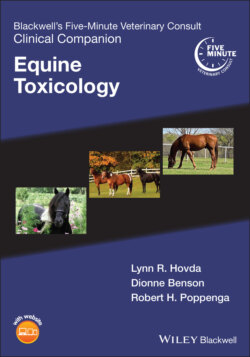Читать книгу Blackwell's Five-Minute Veterinary Consult Clinical Companion - Группа авторов - Страница 49
Detoxication
ОглавлениеActivated charcoal (AC):Many toxicants are adsorbed by AC, thereby reducing the amount of toxicant absorbed from the GI tract.Mix the AC (1–4 g/kg) with warm water to form a slurry.AC binds many organic compounds but is relatively ineffective against inorganic compounds (e.g., heavy metals), mineral acids, and alkali.Follow the AC with a laxative (cathartic) to hasten removal of the toxicant from the intestinal tract.
Cathartics can result in significant diarrhea; therefore, ensure the horse is adequately hydrated:Magnesium sulfate (Epsom salts) is an osmotic laxative that draws water into the intestines. The recommended dose is 250–500 mg/kg mixed in several liters of water.Sorbitol 70% (3 mL/kg) or sodium sulfate (250–500 mg/kg mixed in several liters of water) are alternative cathartics.The efficacy of mineral oil for treating intoxicated patients has not been established and its use is discouraged for routine GI decontamination.
Cholestyramine (cholestyramine) is useful in some intoxications.Some toxicants are eliminated primarily by the fecal route or undergo enterohepatic recirculation. AC/cholestyramine followed by a laxative is the most effective means for increasing elimination of these toxicants.
Many toxicants are eliminated by the kidneys, and, in some cases, renal excretion can be enhanced by increasing urine output via fluid administration. Diuretics can be used to increase urine flow – furosemide (1 mg/kg IV); mannitol (0.25–1.0 g/kg as 20% solution by slow IV infusion).
Manipulating the urine pH can increase the excretion of some toxicants in the urine via ion trapping. Weak acids are ionized in alkaline urine, whereas weak bases are ionized in acidic urine. The normal range of pH for urine in adult herbivores is alkaline (pH 7–9).
